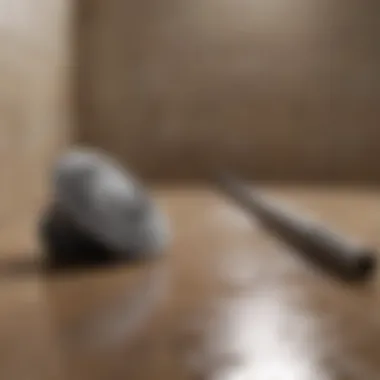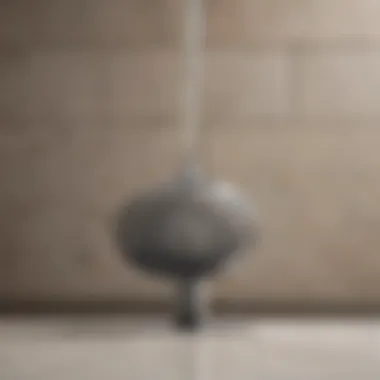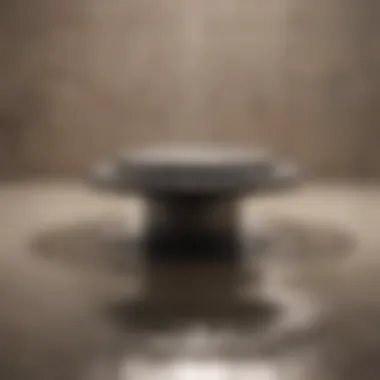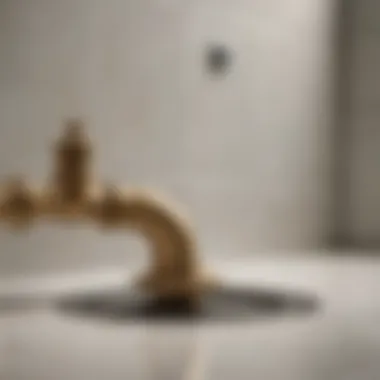A Comprehensive Guide to Cleaning Your Shower Drain


Intro
Cleaning out a shower drain is often overlooked until a problem arises. This task is essential for maintaining a clean and functional bathroom. Over time, hair, soap scum, and other debris can accumulate in the drain, hindering water flow and leading to inconvenient clogs. This article outlines the necessary steps and recommendations for keeping your shower drain clear. Understanding the importance of regular maintenance can save homeowners from expensive plumbing repairs in the long run.
A clean shower drain enhances the overall appearance of the bathroom and ensures a pleasant showering experience.
Design Inspiration
While the topic focuses primarily on practical cleaning methods, it is important to consider the broader context of maintaining a malfunction-free shower space. A well-maintained shower area not only functions effectively but also influences the aesthetics of the bathroom.
Trending Styles
Modern bathrooms often incorporate sleek designs and high-quality materials that require attention to detail. When maintaining your shower drain, consider using materials and layouts that allow for easier access and cleaning. Raised shower floors and easy-to-remove drain covers promote functionality without compromising style.
Color Palettes
Selecting drain finishes that match the overall color scheme of a bathroom can create a cohesive look. Stains and discoloration can often be more visible on certain colors, so selecting neutral or darker tones may help hide signs of wear and grime.
Practical Tips
Keeping your shower drain clean is a straightforward process, but it requires diligence and the right tools. Here are some practical steps to ensure longevity and functionality of your shower drainage system.
Maintenance & Care
- Regular Inspections: Check the drain at least once a month to catch any buildup before it becomes a larger problem.
- Use a Drain Cover: A drain cover can catch hair and debris, minimizing what enters the drain. Clean it regularly to prevent overflow.
- Flush with Hot Water: Running hot water down the drain can help dissolve soap scum and grease. Aim for this proactive measure once a week.
Budgeting & Planning
Cleaning your shower drain does not need to be costly. Here are some budget-friendly options:
- DIY Cleaning Solutions: Use baking soda and vinegar for a natural cleaning method. Pour half a cup of each into the drain, let it sit for thirty minutes, then flush with hot water.
- Invest in Tools: A basic plumbing snake or a drain cleaning stick can be purchased for a low-cost solution.
- Plan Routine Maintenance: Set reminders for regular cleaning and maintenance. This proactive approach will save you money by reducing the chances of clogs and damage.
"An ounce of prevention is worth a pound of cure." Regular maintenance prevents inconvenient plumbing issues.
Epilogue
Foreword to Shower Drain Maintenance
Maintaining a clean shower drain is essential for every household. Over time, hair, soap scum, and debris accumulate in the drain, leading to clogs and unpleasant odors. When a shower drain is neglected, these issues can escalate, resulting in more significant plumbing problems that are costly and time-consuming to fix.
Understanding the Importance of Clean Drains
A clean shower drain ensures proper water flow and reduces the risk of flooding in your bathroom. Dirty drains can also harbor bacteria and mold, posing health risks to occupants. Regular maintenance helps to extend the life of your plumbing system, making it a fundamental aspect of home care. Additionally, clean drains minimize the frequency of plumbing service calls, saving homeowners money in the long run.
Common Issues Associated with Clogged Drains
Clogged shower drains present various challenges. The most common issues include:
- Slow Drainage: Water may take longer to drain, causing a temporary pool in the shower.
- Unpleasant Odors: Accumulated debris can emit foul smells that linger in the bathroom.
- Water Backups: Severe clogs can lead to water backing up into the shower, which is an obvious indicator of a significant problem.


Addressing these issues promptly not only prevents further complications but also maintains a pleasant bathing environment.
Identifying Signs of a Clogged Shower Drain
Identifying signs of a clogged shower drain is crucial for maintaining the integrity of your plumbing system. Recognizing these warning signals in a timely manner allows homeowners to take preventative action, which can save both time and money in the long run. Ignoring the early indicators of clogs can lead to more severe blockages, resulting in costly repairs. Thus, understanding the common symptoms is necessary for achieving a well-functioning plumbing system.
Slow Drainage
One of the most prevalent signs of a clogged shower drain is slow drainage. When water takes longer than usual to work its way down the drain, it could suggest a buildup of hair, soap scum, or other debris. Slow drainage may start off as a minor inconvenience but can quickly escalate into a significant issue. Homeowners may initially try to ignore it, believing that it will resolve itself. However, this approach can be detrimental. Regular assessment of drainage speed and promptly addressing slow movement can help prevent more serious clogs.
Unpleasant Odors
Unpleasant odors emanating from the shower drain can be another telling sign of trouble. These odors often result from stagnant water or the decomposition of organic material trapped within the pipes. In some cases, bacteria may thrive in these conditions, presenting both a hygiene concern and an unpleasant experience. If one notices a strong smell, it is essential to investigate the source quickly. Ignoring this phenomenon could lead to more severe problems, including water damage and costly repairs.
Water Backups
Water backups represent one of the most alarming symptoms of a clogged shower drain. When water begins to gather in the shower basin instead of draining away, it poses immediate problems. This situation may not only lead to unsightly water pooling but also to structural issues within the bathroom. Frequent backups can indicate a significant buildup deeper in the plumbing system, necessitating immediate attention. Homeowners should not dismiss this warning sign, as it indicates a critical need to maintain proper drain function.
Essential Tools for Cleaning a Shower Drain
Cleaning a shower drain effectively requires the right tools. Having these tools on hand can save time and effort, making the task less daunting. Each tool serves a unique purpose, enabling homeowners to tackle debris buildup and maintain proper drainage. Here, we outline the essential tools needed for this task, highlighting their importance and functionality.
Basic Cleaning Supplies
Basic cleaning supplies are the foundation of any drain cleaning endeavor. These items are readily available in most households, making them a convenient choice to start with. Key supplies include:
- Gloves: Protect your hands from dirt and bacteria. Disposable rubber gloves are ideal due to their resilience and ease of cleanup.
- Bucket: Useful for collecting debris and waste material. A sturdy bucket helps contain the mess, keeping the work area tidy.
- Old Towels or Rags: Used to wipe surfaces and absorb any spills. They also provide a good way to clean up after the job is done.
- Disinfectant Cleaner: Helps sanitize surfaces once the cleaning is complete. Look for solutions that are effective against mold and mildew, as these can accumulate in shower areas.
These basic supplies ensure that the cleaning process is organized and hygienic. The right care during cleaning reduces the risk of cross-contamination in your living space, promoting not just cleanliness, but health as well.
Drain Cleaning Tools
In addition to basic supplies, specialized drain cleaning tools can greatly aid in clearing blockages. The following tools are specifically designed to address common drain issues and improve cleaning efficiency:
- Plumber's Snake: This is a flexible auger designed to reach deep into pipes. It helps remove stubborn clogs by breaking apart blockages or pulling them out entirely.
- Drain Cleaning Brush: A brush with stiff bristles can clean the inner walls of pipes. It helps remove buildup, ensuring the water flows freely.
- Drain Strainer: Often used during normal use, this simple yet effective tool catches hair and debris before it enters the drain. Installing a strainer can drastically reduce future clogs.
- Wet/Dry Vacuum: A vacuum with a wet function can remove both water and debris. This tool is efficient for managing larger clogs or water backups.
By equipping oneself with these tools, homeowners can confront the issue of clogged drains head-on. Investing in the right tools not only eases the cleaning process but also prolongs the lifespan of the plumbing system. Keeping a dedicated cleaning kit accessible ensures a proactive approach to drain maintenance, providing peace of mind down the line.
"An ounce of prevention is worth a pound of cure."
Regular maintenance with the proper tools minimizes the risk of severe problems later on. Adhering to these practices can keep your shower drains functioning smoothly.
Step-by-Step Guide to Clean a Shower Drain
Cleaning a shower drain is an essential task that not only prevents unwanted odors but also ensures proper drainage. In this guide, we will outline each step required to clean a shower drain effectively, while highlighting the importance of thoroughness and consistency in drain maintenance. A well-maintained shower drain enhances the overall hygiene of your bathroom and can prevent costly plumbing repairs down the line.
Preparing the Area
Before starting the cleaning process, it is crucial to prepare the area around the shower. Remove any items such as bottles, sponges, or mats that might get in the way. This step facilitates easy access to the drain and minimizes the risk of spilling any cleaning solution on your belongings.


Additionally, consider placing an old towel or newspaper on the floor to catch any debris that may fall during the cleaning. Wearing rubber gloves is also recommended to protect your hands from dirt and cleaning products. Taking these initial steps will save you time and frustration during the process.
Removing the Drain Cover
To access the clog, you must first remove the drain cover. Depending on the model of your shower, the cover can be a simple lift-off design, or it may require unscrewing. If it's screw-type, use a screwdriver that matches the screw head. Be careful not to scratch or damage the surrounding tiles while removing the cover. Once removed, set the cover aside in a safe location so that it doesn’t get misplaced.
Clearing Debris
After removing the drain cover, visually inspect the drain for visible debris such as hair, soap scum, and other build-up. You can use a straightened coat hanger or a specialized drain claw tool to reach deeper into the drain and pull out any trapped material.
It is vital to clear as much debris as possible, as this often is the primary cause of clogged drains. Use the personal protective equipment mentioned earlier and dispose of the debris properly in a trash bag or compost if applicable.
Using Drain Cleaning Solutions
At this stage, you can apply a drain cleaning solution. There are many options available, ranging from commercial drain cleaners to natural solutions like a mixture of baking soda and vinegar. If using commercial products, follow the instructions on the label closely. The solution should sit in the drain for the recommended duration to dissolve remaining build-up.
Natural solutions are often quieter but may take longer to work. If using baking soda and vinegar, pour half a cup of baking soda down the drain, followed by half a cup of vinegar. Wait a while before flushing the drain. Always remember to ventilate the area when using strong cleaners to avoid inhaling harmful fumes.
Flushing the Drain
Flushing the drain is an important concluding step. Turn on the hot water tap and allow it to run for several minutes. This action helps clear any loosened debris and cleaning solution from the pipes, ensuring a thorough clean. It’s also beneficial to use a high-pressure spray if your shower head allows it, as this can push out residual materials further down the pipe. Effective flushing will enable smooth drainage and minimize the chances of future clogs.
Reattaching the Drain Cover
After flushing the drain, check to make sure everything is clear. Once satisfied, proceed to reattach the drain cover carefully. If there were screws, ensure they are tightened securely, but avoid overtightening as this might damage the cover or surrounding area.
By maintaining this routine, you will enhance your shower experience and lengthen the life of your plumbing. Regular attention to drain cleanliness can save you the inconvenience and cost associated with severe clogs.
Preventative Measures for Maintaining a Clean Shower Drain
Keeping a shower drain clean requires consistent effort. Preventative measures are essential for maintaining a free-flowing drain. Addressing problems before they escalate saves both time and money. It is wise to implement certain practices to avoid future clogs. Regular maintenance can significantly extend the life of your plumbing and enhance your showering experience.
Regular Cleaning Routines
Implementing a cleaning routine is critical. Aim to clean your shower drain at least once a month. Simple tasks like removing hair and debris can make a huge difference. Take a few minutes after each shower to inspect the drain. Using a pair of gloves, pull out any visible hair or buildups. This minimizes the amount that collects over time.
Additionally, consider a deeper cleaning at least twice a year. Create a solution of equal parts baking soda and vinegar. Pour this mixture down the drain. Wait for about 15 minutes, then flush it with hot water. This natural method dissolves any soap scum and buildup.
Using Drain Screens
Drain screens are effective tools for preventing debris from entering the drain. They are designed to trap hair and larger particles without letting them go down the pipe. Installing a high-quality drain screen is inexpensive and very easy. They come in various shapes and sizes to fit most shower drains.
To maintain the effectiveness of drain screens, remember to clean them regularly. Remove any accumulated hair and other materials at least once a week. A clean screen allows water to flow freely, reducing the risk of clogged drains.
Minimizing Hair and Soap Buildup
Hair and soap scum are leading contributors to clogged drains. To minimize this, try to be mindful during showers. Brush or tie your hair before you shower, especially if it is long. This reduces the amount of hair that sheds during your wash.
Using liquid soaps instead of bar soaps can also help. Bar soaps tend to leave more residue behind. If you prefer bar soap, choose brands that dissolve easily in water. Regularly rinsing the shower floor can help to wash away soap scum before it builds up.


In summary, taking small, consistent steps can lead to a cleaner and well-functioning shower drain. Adopting these preventative measures will help you maintain your shower's plumbing and prolong its life.
Common Myths About Shower Drain Cleaning
Understanding common myths regarding shower drain cleaning is vital for maintaining a clean and functional plumbing system. Misconceptions can lead homeowners to employ ineffective methods or skip necessary actions altogether. Acknowledging these myths allows individuals to adopt better practices, enhancing both their cleaning routines and overall plumbing maintenance.
Liquid Drain Cleaners
Liquid drain cleaners are often viewed as a quick fix for clogged drains. Many believe that pouring these chemicals down the drain will solve any blockage. However, this assumption overlooks several critical factors.
Firstly, many liquid drain cleaners contain harsh chemicals that can damage pipes over time, particularly if used frequently. Plastic pipes are especially vulnerable, as these chemicals can degrade the material. Additionally, while these products might clear minor clogs, they often fail to address the underlying issues that cause blockages, such as hair buildup or soap residue. Instead of relying solely on chemical solutions, homeowners should consider regular preventative maintenance alongside limited use of these cleaners.
Another significant issue with liquid drain cleaners is the potential hazards they pose. These substances can release toxic fumes, creating health risks during their application. Users must take proper precautions, including wearing gloves and ensuring proper ventilation. Therefore, it is wise to approach liquid drain cleaners with caution, using them sparingly and combining them with other cleaning methods for effective results.
Professional Help Requirements
Many homeowners believe they can handle all shower drain issues on their own. However, some situations clearly require professional assistance. Ignoring this can lead to more significant problems down the line.
Signs that indicate the need for a professional plumber include persistent slow drainage even after cleaning attempts, recurring clogs despite regular maintenance, and any unpleasant smells that do not subside. Additionally, visible leaks or water damage around the shower area signal deeper plumbing issues that an expert needs to assess.
Furthermore, attempting to resolve complex plumbing problems can worsen the situation. The right tools and expertise are essential for identifying and fixing underlying problems. Homeowners should not hesitate to seek professional assistance when necessary, as it often leads to more long-term solutions and avoids further potential damage.
Recognizing the limits of what can be handled personally is crucial in maintaining shower drains and overall plumbing health.
The reality is that effective shower drain maintenance requires a blend of prevention, appropriate tools, and, at times, professional help.
When to Call a Professional Plumber
Engaging in maintenance around the home is a vital aspect of homeownership. However, not every issue can be resolved with basic tools and a bit of elbow grease. Knowing when to seek professional assistance is crucial, especially when it comes to plumbing problems. Calling a professional plumber can save time, prevent further damage, and ensure that the issue is resolved correctly.
One of the key benefits of consulting a professional is accessing their expertise. Plumbers are trained to identify underlying causes of drain problems, such as misaligned pipes or blockages located deep within the plumbing system. They come equipped with specialized tools that allow them to tackle complex issues that are beyond the reach of standard cleaning methods.
Additionally, attempting to address plumbing problems without proper knowledge can lead to further complications. For instance, using harsh chemicals in a clogged drain can cause more significant problems like pipe corrosion or leaks. A plumber understands the correct approaches to take, minimizing risks and ensuring that your plumbing system remains intact.
Considerations for calling a plumber include the frequency and severity of the issues. If you find yourself facing repeated clogs or recurrent unpleasant odors despite regular maintenance, it may indicate a more serious issue that requires professional evaluation.
Remember: Procrastination in seeking help can lead to more severe plumbing problems later on. It's always better to address such issues sooner rather than later.
Signs That Indicate a Serious Issue
Recognizing signs that indicate a more profound plumbing issue is essential for homeowners. Here are common indicators that suggest you should consider reaching out to a professional plumber:
- Persistent Clogs: If clogs occur frequently, this may signal deeper blockages that regular maintenance cannot correct.
- Multiple Drain Issues: If several drains are slow or backing up at once, it may indicate a primary line issue, rather than isolated incidents.
- Unusual Noises: Gurgling or bubbling sounds when water is draining can point to trapped air or blockages in the plumbing system.
- Water Damage or Molds: Visible signs of water damage or mold growth around the shower area can indicate leaks or persistent drain issues.
- Slow Draining Water: A sluggish drain that does not respond to home remedies is often a sign of severe blockage.
Being aware of these signs can aid in deciding whether to contact a professional plumber. Addressing plumbing issues promptly can save costs and protect your property.
Ending
Maintaining a clean shower drain is more than just a minor household task; it is crucial for the overall health of your plumbing. This article emphasizes the various aspects of drain maintenance, detailing why regular cleaning should be a priority for homeowners. A neglect of this duty often leads to problems such as slow drainage, unpleasant odors, and even serious plumbing emergencies that require costly repairs.
The benefits of maintaining your shower drain include improving water flow, reducing the risk of clogs, and prolonging the lifespan of your plumbing system. Furthermore, a clean drain contributes to a more pleasant showering experience, free from undesirable smells or the annoyance of stagnant water accumulation.
One significant consideration discussed here is how preventative measures can save both time and money in the long term. By implementing regular cleaning routines, using drain screens, and being mindful of what goes down the drain, individuals can help avert serious clogging issues that require professional intervention.
"Regular shower drain maintenance is not just a good practice; it is an essential responsibility for any homeowner."
Thus, the importance of drain maintenance should resonate not only as a recommended practice but as a necessity for maintaining a functional and hygienic household environment. An effectively maintained shower drain offers benefits that extend beyond mere convenience, reflecting responsible homeownership that prioritizes both functionality and sanitation.















